Holiday decorations : avoid hazards to our pets
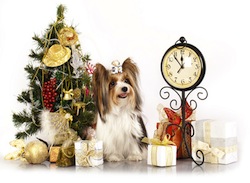 The year-end holiday season may present a dangers sometimes unsuspected for our pets : FIR, set designer, ornamental plants… are risk of injury, of intoxication, or accidents that can be often avoided with knowledge of these risks.
The year-end holiday season may present a dangers sometimes unsuspected for our pets : FIR, set designer, ornamental plants… are risk of injury, of intoxication, or accidents that can be often avoided with knowledge of these risks.
What's more stressful than having, during the holidays, emergency run to her veterinarian or find a clinic guard?
The holidays of years yet unfortunately give rise to an urgent consultations increase, consultations due to some indiscretions of our companions…
For that nothing will ruin your holidays, you can take some precautions.
Prevent the risk of injury
Prevent the risk of shock
What ultimately more than trying to play with the tree for a dog or cat ? And not only in young animals !
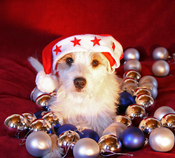 The risk of tree fall is to consider whether it is because the animal tries to climb it or because he wants to play with the decorations he wears. As one would do vis-à-vis children, it should ensure the stability of the tree to prevent injury.
The risk of tree fall is to consider whether it is because the animal tries to climb it or because he wants to play with the decorations he wears. As one would do vis-à-vis children, it should ensure the stability of the tree to prevent injury.
Prevent the risk of cuts
More than the tree itself, these are the sets that are used to his ornament that can be dangerous for the dog, the cat or the NAC (new pets). All decors likely to break (bowls, candlesticks…) shall be posted in height to avoid failure.
Prevent electrical shock
The fairy lights have a risk of electric shock in dogs, chat and even more in some NAC as ferrets and rodents especially like snacking all that their graves “under the tooth”. These wreaths will be placed out of their reach, or protected with special ducts.
Preventing the risk of strangulation
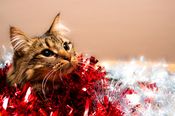 Garlands 'traditional' exhibit, as for them, a strangulation hazard to animals that would be tempted to play with.
Garlands 'traditional' exhibit, as for them, a strangulation hazard to animals that would be tempted to play with.
Trapped ", animals often tends to struggle, which makes things worse. He still serves more rope around his neck causing significant respiratory distress up to cause the animal's death.
Preventing the risk of suffocation
The ingestion of pieces of garland and more or less quantity can, Furthermore, cause choking coming obstruct the bottom of the throat of the animal
It should also be wary of decorations such as "Angel son", finer still than traditional garlands and they too can cause choking.
The problem is that often, the animal has ingested this type of decoration is not caught in the act. Any animal that shakes his head or give paw shots on the muzzle should attract the attention of his master.
The first thing to do before driving without waiting for an animal suffering from suffocation or strangulation to the vet is trying, if it's possible, to find what causes ... trying to open his mouth and pulling the object.
Prevent occlusion
Garlands and other objects that are described as "linear" (son curtains, ties trash bags… ) will, not only, can cause the animal's death by strangulation or suffocation but they can also be responsible for intestinal obstruction, as tiny element decor (pieces topics, pieces balls…) which could be ingested by the animal.
Occlusion occurs when the animal is unable to remove naturally absorbed object. Depending on the room charge, there is a risk of stopping the digestive transit, perforation, or peritonitis. We must therefore react immediately and consult your veterinarian as soon as possible.
Depending on the location of the object, unrest will worsen and general condition of the animal degrade more or less quickly.
There still, the animal has not been seen in the process of absorbing the foreign body. This will make it more difficult diagnosis, especially as the first symptoms (gene, refusal to eat, vomiting, constipation or diarrhea, more or less bloody, apathy, refusal to set ...) may take more or less time to appear.
Any change in your pet's behavior and any deterioration of his general condition should alert you.
A precise description of these disorders can direct your vet and help in its diagnosis.
It will conduct a thorough auscultation. Palpation sometimes will detect a foreign body but a radiograph, ultrasound or endoscopy will often be necessary to highlight and locate the foreign body.
In some cases, Medical treatment may be. This applies to small parts that present no risk of injury during their transit through the digestive tract.
Except for these cases, the veterinarian will perform surgery after rehydration of the animal to remove the object in question.
Preventing burns
 In times of Christmas and New year, many candles are often part of the decor.
In times of Christmas and New year, many candles are often part of the decor.
In this case, attention to the risk of burns, especially with small candles kind “night lights” which are often easily accessible by animals.
A small burn comes in the form of redness on the skin surface.
For minor burns, the affected part must be passed in cold water, disinfected with an antiseptic solution (Betadine, Effectiveness 5%…) then covered with a lotion or healing ointment. A bandage will then be applied and changed daily.
If the burn, even small, A fragile place (eyes, mouth, articulations…), it is a 2nd degree burn (blister filled with water) or 3rd (dermis, epidermis and lower layers of the skin then being achieved), you should contact your as soon as possible veterinarian to conduct an examination of the wound, cleans as appropriate and considers the treatment to put in place to limit the risk of superinfection.
To retain : you should never put grease on a burn.
Preventing the risk of poisoning
During the Christmas and New Year festive several kinds of plants are used to decorate the house.
These plants should never be left within reach of your pets because many of them are toxic by contact or ingestion.
This is particularly true of the poinsettia, you gui, holly and yew, sort of pine that is used among others for making Advent wreaths. Individuals most affected by these poisonings are young people who like to discover their environment by "chewing" or by ingesting various objects in their environment.
The poinsettia or "Christmas star"
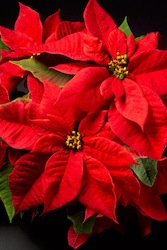 It is prized for its decorative effect, but repeated contact with this plant or its ingestion in large quantities by your pet can have serious consequences…Its toxicity is related to the presence of various substances in the plant including the latex. The most toxic parts are the stems and leaves. The mucous membrane contact with toxic substances or ingestion of these plant parts in large quantities can trigger various symptoms:
It is prized for its decorative effect, but repeated contact with this plant or its ingestion in large quantities by your pet can have serious consequences…Its toxicity is related to the presence of various substances in the plant including the latex. The most toxic parts are the stems and leaves. The mucous membrane contact with toxic substances or ingestion of these plant parts in large quantities can trigger various symptoms:
– Of eye damage : redness, conjunctivitis, swelling of the eyelids, or dilated pupils and vision loss.
– Of skin lesions : skin contact with latex can present significant inflammation with possible appearance of small blisters or edema.
– Of digestive disorders : mouth irritation, gastric irritation with vomiting.
The animal intoxicated refuses to eat, abdominal pain may show signs of diarrhea and suffer more or less marked.
In cases of massive ingestion of the plant, animals intoxicated shows signs of agitation, general disorders (pallor, sweating, hypothermia, chills…) and more severe symptoms can occur such as:
haematological disorders (destruction of red blood cells),
heart problems (cardiac rhythm disorders, hypotension) or neurological disorders (muscle tremors, dizziness…) can evolve until the death of the animal.
Rinsing eye saline can be achieved in case of contact of the latex with the latter. It is then necessary to take the dog or cat intoxicated as quickly as possible to the vet so that he can develop a suitable treatment
Le Gui
The mistletoe contain a substance called viscotoxine causes, a few hours after its absorption by an animal, different types of disorders:
– Digestive disorders : salivation, vomiting, diarrhea observed a few hours after eating berries.
– Grave hypotension
– nervous : dilated pupils, increase sensitivity of the animal (which excessively reacts to the slightest little stimulus), or even approach abnormal (with incoordination in movements and balance disorders)
The symptoms are variable depending on the dose ingested and the size of the animal. Massive ingestion of mistletoe can be fatal.
There is no antidote against viscotoxine.
If you have seen your pet ingest mistletoe berries or if you suspect of having swallowed, make you immediately to your veterinarian.
The toxicity of mistletoe is not negligible, It is appropriate to monitor your pet and make sure that it has access or directly to the plant, or arrays that could fall to the ground.
Holly
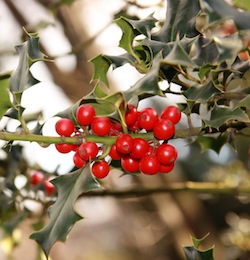 Just like those of the gui, Holly berries are toxic. The Holly leaves also exhibit some toxicity but are rarely eaten because of the presence of the Quills on their surface.
Just like those of the gui, Holly berries are toxic. The Holly leaves also exhibit some toxicity but are rarely eaten because of the presence of the Quills on their surface.
The symptoms following the holly absorption are those of an oral irritation (important salivation), irritation of the digestive tract (vomiting, diarrhea, abdominal pain) and possible nerve damage if the berries are ingested in very large quantity.
The toxicity of Holly is less significant than the gui and its absorption is rarely fatal.
In all cases, Poisoning is a veterinary emergency and should be consulted without waiting. Do not make eating or drinking the animal and especially not give milk which is said that it is a poison. Belief that the hard life !
If we took the animal to the fact, it is useful to bring to the vet a piece of the plant ingested, which will facilitate the rapid establishment of a suitable treatment.
This article is brought to you by the animal health insurance, santevet.com
